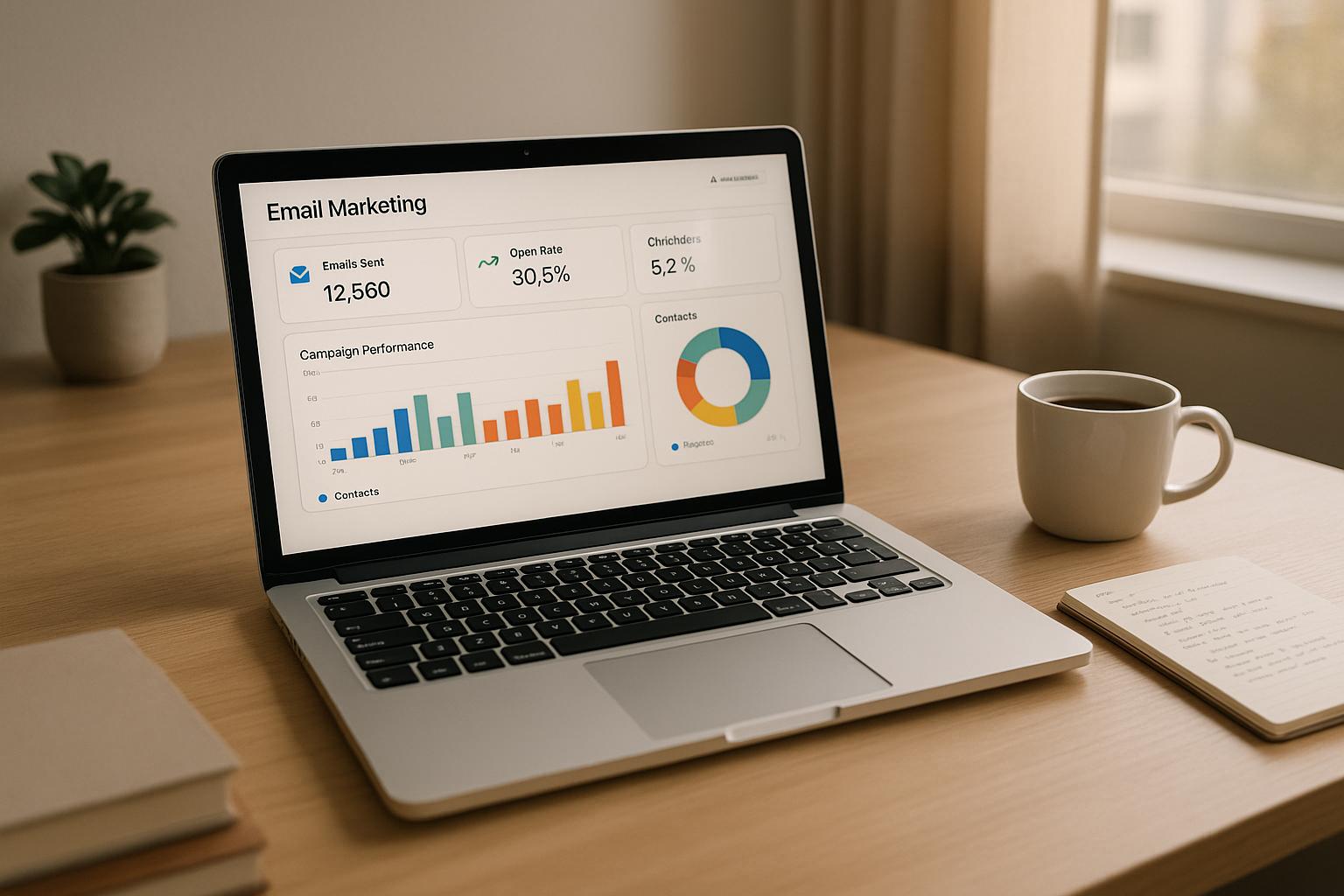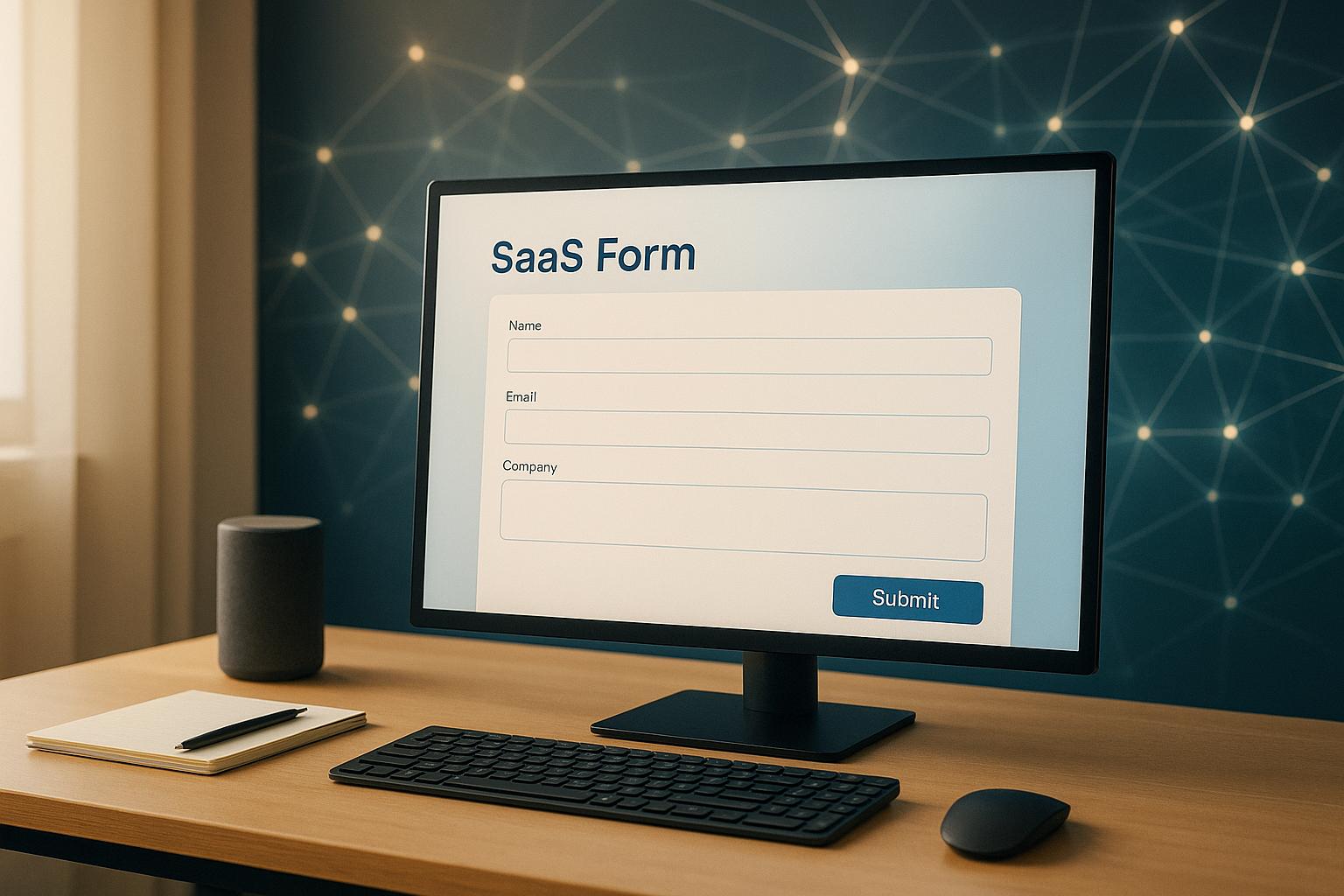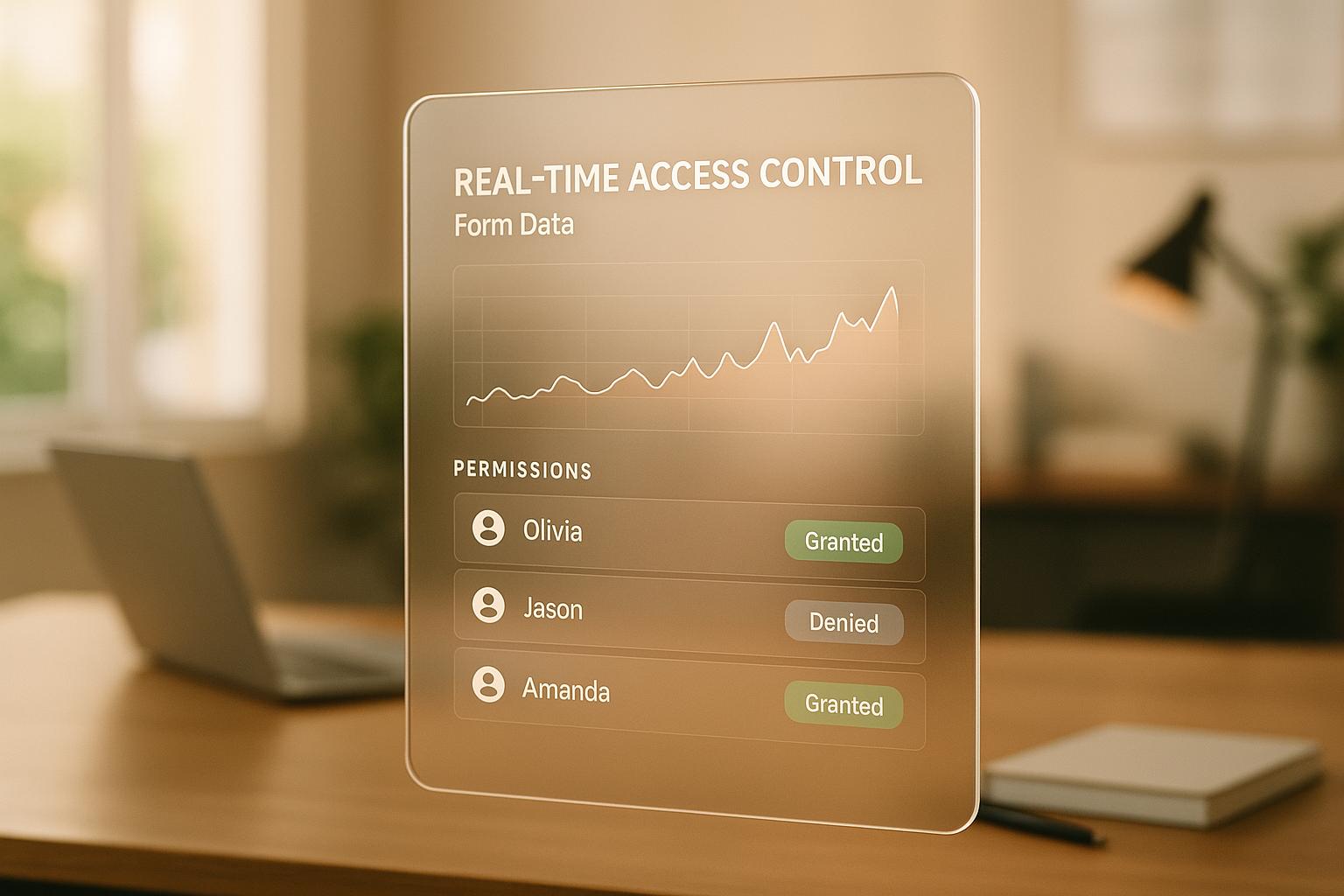Email Campaign Data for Better Lead Scoring

Using email campaign data can significantly improve how you score and prioritize leads. Instead of relying solely on demographic details, tracking email interactions - like opens, clicks, and downloads - provides a clearer picture of buyer interest. This approach helps businesses focus on leads most likely to convert, boosting efficiency and ROI.
Key Takeaways:
- Behavioral insights matter: Email engagement metrics (e.g., open rates, click-throughs) offer real-time indicators of interest.
- Scoring system basics: Assign points to actions (e.g., 2 points for opens, 5 for clicks, 10 for downloads) to rank leads effectively.
- Integration is crucial: Sync email platforms with CRMs for real-time updates and better sales alignment.
- Automation and AI: Automating lead scoring and using AI to analyze patterns can improve accuracy and save time.
- Proven results: Companies using lead scoring report 77% higher ROI and 50% more sales-ready leads at 33% lower costs.
By leveraging email data and refining scoring models regularly, businesses can improve lead prioritization, reduce costs, and increase conversions. Tools like Reform make this process easier by integrating email, CRM, and marketing platforms seamlessly.
Lead Scoring Basics
What is Lead Scoring?
Lead scoring is a methodical way of ranking potential customers based on how likely they are to become paying clients. It works by assigning scores to leads using two main types of information: explicit data and implicit data.
- Explicit data includes details that leads directly share, such as their job title, company size, industry, or location. Think of it as the information you gather from forms or surveys.
- Implicit data, on the other hand, is all about behavior. It tracks actions like email opens, website visits, content downloads, or attendance at events.
Combining these two types of data gives a clearer picture of a lead’s potential. For example, a marketing director at a Fortune 500 company might score high on explicit data because of their decision-making role and the size of their company. But if they rarely engage with your emails or website, their implicit score would be low, signaling limited interest.
This system boils down to assigning points based on actions and attributes. For example:
- 2 points for opening an email
- 5 points for clicking a link
- 10 points for downloading a resource
- 20 points for abandoning a cart at checkout
Demographic factors, like being in a target industry or holding a key role, add further nuance to the score. The result is a quantified way to prioritize leads.
Now, let’s take a closer look at how behavioral signals refine this scoring process.
How Behavioral Data Affects Lead Scoring
Behavioral data transforms lead scoring into a dynamic, real-time process that adapts to changing interests. Unlike demographic data, which tends to remain stable, behavioral signals offer a snapshot of what a lead is actively doing.
Take email interactions as an example. A lead who regularly opens emails, clicks links, and downloads resources is clearly engaged and moving through the buyer’s journey. Website activity adds even more context - frequent visits to your pricing page, time spent reading case studies, or exploring product features are strong buying signals that deserve higher scores.
This real-time feedback is crucial for prioritizing leads. A prospect who initially seemed disinterested might suddenly start engaging heavily with your content, leading to a quick score boost. This signals your sales team to reach out while their interest is at its peak.
Here’s a real-world example: A furniture manufacturer adopted a predictive lead scoring model that emphasized behavioral data. The result? They cut administrative costs by 8% and boosted profits by 15%.
Behavioral scoring can also identify leads who don’t fit the typical customer profile but show strong engagement. By analyzing historical data, you can pinpoint which behaviors are most closely linked to purchases and assign scores accordingly. This ensures you don’t overlook high-potential prospects just because they fall outside the usual mold.
How To Integrate Email Lead Scoring With CRM? - TheEmailToolbox.com
How Email Campaign Data Improves Lead Scoring
Email interactions have become a game-changer for refining lead scoring. By tracking how prospects engage with your email campaigns, you gain real-time insights into their intentions and interest levels. This kind of behavioral data offers a much clearer picture of lead quality compared to relying solely on demographic information.
One of the biggest advantages of email campaign data is its immediacy. For example, if a lead suddenly starts clicking through multiple emails and visiting your website, they’re signaling a spike in interest. A smart scoring system can pick up on this change instantly, allowing your sales team to act while the lead’s interest is still fresh. Now, let’s break down the specific email engagement metrics that help identify these key signals.
Important Email Engagement Metrics
Certain email engagement metrics stand out when it comes to scoring leads effectively:
- Open rates: These are a good starting point for gauging initial interest and typically earn 2 points.
- Click-throughs: These actions indicate active interest, such as seeking more information, and are weighted more heavily.
- Response times: The speed at which a prospect engages with an email after receiving it can reveal urgency and genuine interest, making it a key factor in prioritizing leads.
- Click location: Where someone clicks within an email matters. For instance, clicking a call-to-action button suggests stronger intent than clicking a general link. Scoring systems assign higher points to actions that indicate readiness to buy.
Personalized emails play a significant role here. Research shows that tailoring email content based on lead scoring data can boost click-through rates by 14% and conversion rates by 10%. This creates a cycle where better scoring leads to better targeting, which then generates more actionable engagement data.
Tracking Email Behavior
Tracking email behavior goes beyond just measuring opens and clicks. It’s about understanding the entire journey, from the moment a lead interacts with an email to their actions on your website. For instance, if a lead clicks an email link and then takes action on your website, such as filling out a form or downloading a resource, they might earn 5 points in your scoring system.
Sustained interest is another critical factor. Leads who repeatedly engage with your emails or revisit your website demonstrate ongoing interest and are typically assigned additional points.
This is where integration becomes essential. By syncing your email platform with a CRM system, you ensure that behavioral data updates lead scores in real time. Companies that do this report 14.5% increases in sales productivity and 36% improvements in sales forecast accuracy. Such integration ensures that your scoring reflects the most current data, making it easier to identify high-priority leads.
Email-Based Lead Scoring Examples
Here’s how scoring might look in practice:
- Basic actions like opening an email earn 2 points.
- Clicking a link adds 5 points.
- High-intent behaviors, such as adding items to a cart, can score between 10 and 20 points.
For example, imagine a lead opens three emails (6 points), clicks a link to download a pricing guide (5 points), visits your product pages twice (4 points), and adds items to their cart but doesn’t complete checkout (20 points). This lead would score 35 points, signaling strong purchase intent.
When leads hit specific score thresholds, automated actions can be triggered. For instance, reaching 30 points might prompt an email offering a discount code. Companies that excel at this type of lead nurturing generate 50% more sales-ready leads at 33% lower cost. The secret is to weigh recent, frequent engagement more heavily than older, one-off interactions - ensuring your scoring reflects current buying intent rather than past curiosity.
sbb-itb-5f36581
Best Practices for Email-Based Lead Scoring
To make your email-based lead scoring strategy effective, it needs to go beyond just tracking opens and clicks. The key is to build a system that connects your tools, sets clear rules, and evolves with changing customer behaviors.
Connecting with CRM and Marketing Tools
For lead scoring to work seamlessly, your email platform, CRM, and marketing tools must integrate smoothly. When these systems are connected, every email interaction updates lead scores in real time, giving your sales team an up-to-date view of each prospect’s interest level.
Consider this: businesses with strong alignment between sales and marketing see a 20% annual growth rate, compared to just 4% for those without proper integration.
Start by ensuring accurate data transfer. Mapping data correctly and eliminating duplicates is crucial to avoid losing key details. If you’re using tools like Reform, features such as lead enrichment and spam prevention ensure only high-quality leads enter your scoring system. Plus, real-time analytics can instantly show how your forms are performing and the quality of leads they’re bringing in.
For more complex setups, webhooks and APIs can connect specialized tools or automate custom workflows. These pipelines ensure every interaction feeds into your lead scoring model, creating a complete view of each prospect’s journey.
Once integration is in place, the next step is setting clear scoring criteria to turn these insights into actionable leads.
Setting Scoring Criteria and Thresholds
A strong lead scoring system relies on clear, weighted criteria that reflect genuine buying behavior. Not all actions are equal - opening an email might earn 2 points, while downloading a pricing guide could be worth 10, and adding items to a cart might score 20.
Base these weights on your own conversion data. For example, if leads who download case studies convert at double the rate of those who simply open emails, your scoring should reflect that. Setting thresholds is equally important. For instance, a lead reaching 30 points might trigger an automated discount offer, while hitting 50 points could prompt a sales alert.
A great example of this in action comes from Coca-Cola Refreshments USA. In 2022, they integrated social media data into their lead scoring system, boosting lead response rates by 4.75%. This led to 2,376 additional leads and a financial gain of $11 million.
Don’t forget to factor in recency and frequency. A lead who interacts with three emails in one week is likely more interested than someone who opened three emails over several months. Give more weight to recent and frequent engagement to capture prospects while their interest is still high.
Once your criteria are set, regularly refine your model to keep up with changes in customer behavior.
Reviewing and Updating Scoring Models
Lead scoring is not a “set it and forget it” system. As market conditions shift and customer behavior evolves, your scoring model must adapt.
Keep an eye on metrics like lead conversion rates, customer acquisition costs, and return on marketing investment. If your highest-scored leads aren’t converting, it’s time to reassess your criteria. A/B testing can help here - experiment with different point values or thresholds and use real-time analytics to see how these changes impact lead quality and conversions.
For instance, Kazemi et al. (2022) implemented a predictive lead scoring model for a furniture company, reducing administrative costs by 8% and increasing profits by 15% through ongoing refinement. Similarly, Peng & Xu (2022) used a decision tree-based model for a mobile communication company, improving marketing effectiveness from 2.1% to 16.1%.
While quarterly reviews are a good rule of thumb, don’t hesitate to make adjustments if you notice significant shifts in customer behavior or conversion trends. Sales team feedback can also be invaluable for refining scoring thresholds.
Companies that excel at continuously improving their lead scoring systems generate 50% more sales-ready leads at 33% lower cost, proving that consistent effort in this area delivers substantial results.
AI and Automation Benefits for Lead Scoring
With the addition of real-time email engagement insights, AI and automation have revolutionized lead scoring. Unlike traditional methods that demand constant manual updates and monitoring, these advanced technologies streamline the process, making it smarter and more efficient.
AI-Powered Lead Prioritization
AI takes lead scoring to the next level by moving beyond simple point-based systems. It dives deep into email engagement data, uncovering patterns that predict sales success. Machine learning algorithms sift through thousands of data points - like email open times, click behaviors, and website actions triggered by email links - to pinpoint the most predictive factors. For instance, a mobile communication company saw its marketing effectiveness leap from 2.1% to 16.1% after adopting AI-driven lead scoring.
What sets AI apart is its ability to learn and adapt over time. Traditional models rely on fixed rules, but AI evolves with changing customer behaviors, adjusting for variables like device usage, timing of engagement, and past interactions. This adaptability delivers real results - companies using AI for lead scoring report up to a 70% increase in ROI from their lead generation efforts.
For businesses leveraging platforms like Reform, AI becomes even more impactful when paired with lead enrichment and real-time analytics. These tools provide the robust data AI needs to make precise predictions. This combination pushes lead scoring far beyond static models, offering dynamic, real-time prioritization.
Real-Time Scoring Updates Through Automation
AI’s insights are amplified by automation, which keeps lead scoring up-to-the-minute. Automation transforms lead scoring into a live process, updating scores instantly with every interaction - whether it’s an email open, a link click, or a content download.
When Reform captures a new lead via a form, the information flows directly into the CRM. From there, automated systems assign an initial score based on the form data and enriched insights. Coca-Cola Refreshments USA showcased the power of this approach by integrating social media data into their automated lead scoring system. The result? A 4.75% boost in lead response rates, 2,376 additional leads, and $11 million in extra revenue.
Automation also enables nuanced lead management. High-scoring leads can trigger immediate alerts to sales teams, medium scorers might enter nurturing campaigns, and low scorers could receive educational content to drive engagement. Businesses that integrate their CRM with marketing automation tools report 14.5% higher sales productivity and a 36% improvement in forecast accuracy.
Conclusion: Better Lead Scoring with Email Campaign Data
Email campaign data has reshaped lead scoring into a precision-driven process. Metrics like opens, clicks, and conversions now serve as clear indicators of purchase intent, providing businesses with actionable insights. Studies show that effective lead scoring not only boosts ROI but also increases the number of sales-ready leads while cutting costs. This underscores the importance of regularly refining scoring models to stay competitive.
The real game-changer is viewing email engagement metrics as predictive tools rather than mere vanity statistics. Real-world examples highlight how integrated lead scoring systems yield tangible, measurable outcomes. These insights prove that analyzing email behavior can directly influence revenue growth.
Integration is the backbone of success. When CRM systems align with email-based lead scoring, sales productivity improves, and forecasting becomes more accurate. Companies that foster alignment between sales and marketing teams through shared lead scoring frameworks enjoy a 20% annual growth rate, compared to just 4% for those without such alignment.
For businesses aiming to refine their lead scoring processes, platforms like Reform offer a clear advantage. With tools like lead enrichment, email validation, and seamless CRM integration, Reform ensures high-quality lead data from the outset. Its focus on driving conversions has delivered a 215% increase in qualified leads for B2B companies, setting the stage for more effective email campaigns.
The organizations that thrive will be those that embrace ongoing improvement. Continuously revisiting and tweaking scoring models based on performance data ensures adaptability to evolving customer behaviors. With 68% of top-performing marketers crediting their success to lead scoring processes, the real question isn’t whether to adopt email-based lead scoring - it’s how soon you can start using it to gain an edge over the competition.
FAQs
How does using email campaign data with CRM systems improve lead scoring?
Combining data from your email campaigns with your CRM system can significantly improve lead scoring. By merging metrics like email opens, clicks, and replies with CRM insights such as demographics, website activity, and purchase history, you gain a deeper understanding of how engaged your leads truly are.
This integration allows businesses to pinpoint high-quality leads with greater precision. The result? You can channel your efforts toward prospects who are more likely to convert, boosting both marketing efficiency and sales performance.
How does AI enhance the accuracy and effectiveness of lead scoring models?
AI has transformed the way businesses approach lead scoring by analyzing massive amounts of data to uncover patterns and predict which leads are most likely to convert. Using machine learning algorithms, it evaluates factors like email interactions, website behavior, and demographic information to rank and prioritize leads more effectively.
With this approach, businesses can channel their energy toward prospects with the highest potential, fine-tune their marketing strategies, and boost conversion rates. Plus, AI doesn’t stay static - it keeps learning and evolving, ensuring lead scoring models stay sharp and aligned with changing trends.
How do email engagement metrics like open rates and click-through rates impact lead scoring?
Email engagement metrics, like open rates and click-through rates, are key indicators for fine-tuning lead scoring. These metrics reveal how engaged a prospect is with your content, helping you determine which leads deserve more attention. For example, a high click-through rate often suggests a strong interest in your product or service, marking the prospect as a higher-priority lead.
When you integrate behavioral data into your lead scoring model, it becomes easier to pinpoint prospects with a higher likelihood of conversion. This targeted approach allows you to focus your sales and marketing efforts on the most promising leads, boosting both conversion rates and your overall ROI.
Related Blog Posts
Get new content delivered straight to your inbox

The Response
Updates on the Reform platform, insights on optimizing conversion rates, and tips to craft forms that convert.
Drive real results with form optimizations
Tested across hundreds of experiments, our strategies deliver a 215% lift in qualified leads for B2B and SaaS companies.





